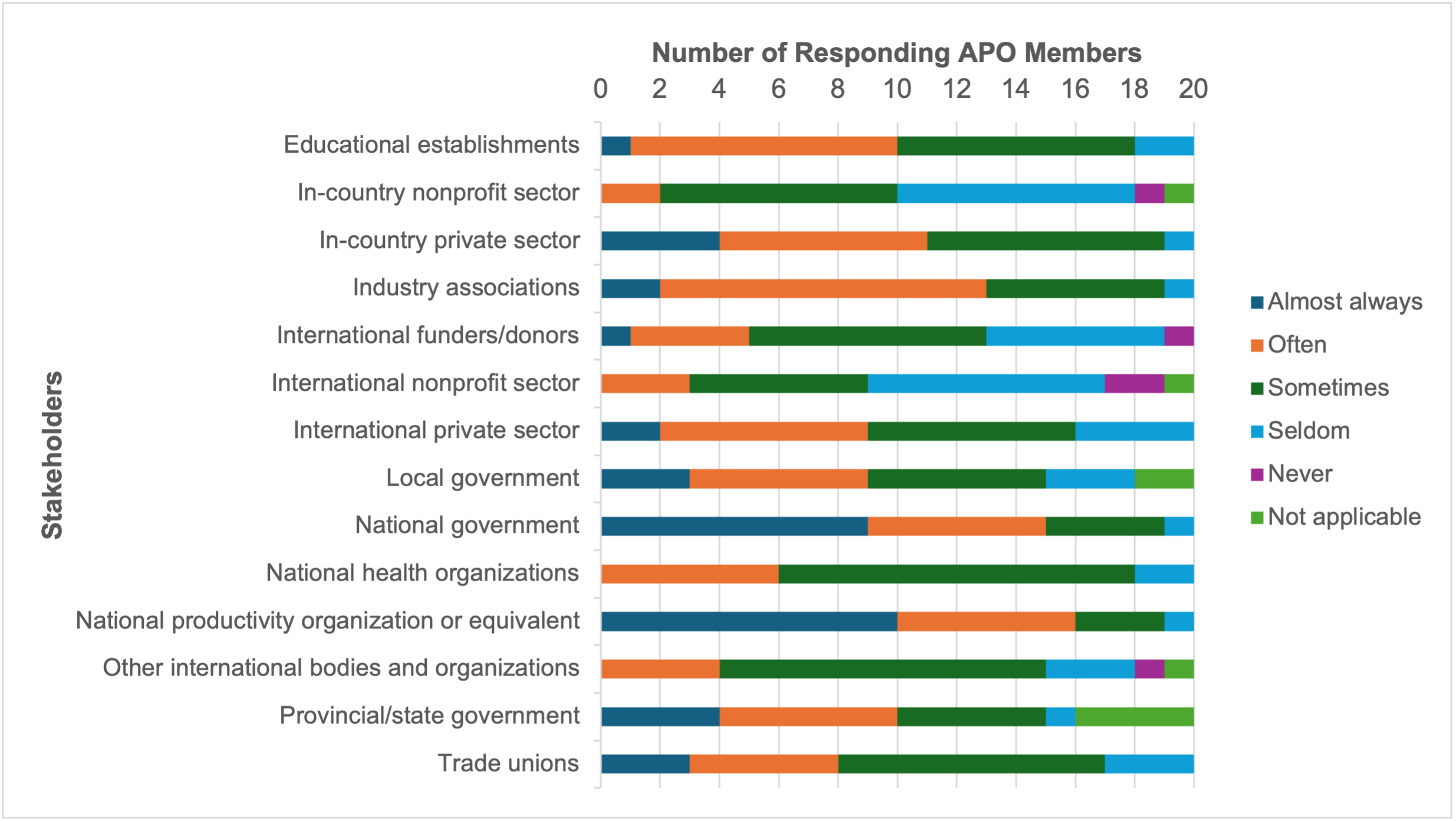
Select Page

To promote productivity and ultimately improve living standards, public policies must focus on enhancing the productive capacity of the economy. Through their policies, governments can influence the underlying determinants of productivity such as taxation systems and quality of infrastructure (APO, 2020). The formulation of such policies poses a considerable challenge for governments, and their implementation is even more complex due to bureaucratic structures, competing priorities, and the fragmented nature of productivity policies. Although there is no universal design that addresses this challenge, it is widely acknowledged that “pro-productivity” public policies must ensure that all productivity-promoting institutions align their operations and policies with one another to achieve a set of clearly defined productivity targets.
Productivity Priorities and Stakeholders
APO member economies have varying priorities when it comes to productivity across sectors, subsectors, and cross-cutting themes. In 2024, the APO commissioned a study to assess member economies’ needs and priorities. Member economies ranked increasing productivity in most industry sectors and subsectors as a “high” or “very high” priority (Figure 1), with a similar sentiment emerging among cross-cutting themes (Figure 2).
Figure 1. Top 10 industry sectors and subsectors ranked “high” and “very high” priority by APO members.

Note: This figure lists only the top 10 sectors and subsectors included in the needs assessment. The needs assessment research was conducted for internal purposes and is currently unpublished.
Source: Created using data from needs assessment research commissioned by the APO involving 20 APO member economies in 2024.
Figure 2. High-priority cross-cutting themes in terms of productivity in APO members.

Note: This figure lists only the top 11 cross-cutting themes included in the needs assessment. The needs assessment research was conducted for internal purposes and is currently unpublished.
SMEs, small and medium-sized enterprises.
Source: Created using data from needs assessment research commissioned by the APO involving 20 APO member economies in 2024.
This suggests that even though APO members prioritize productivity, their focus is divided between different industry sectors and cross-cutting themes. Aligning priorities across diverse sectors while accounting for national and regional contexts can be difficult as each sector is usually managed by a different government ministry or agency. As a result, many economies face the challenge of balancing sector-specific policies with broader cross-cutting strategies, making it difficult to develop policies that effectively address all areas of national productivity improvement. In addition, stakeholders from the private sector, nongovernmental organizations, and international bodies are increasingly being recognized as vital contributors to national productivity (Figure 3). Each brings with them their own priorities and approaches, further complicating the already labyrinthine productivity policy environment.
Figure 3. Stakeholder involvement in delivering productivity improvement among APO members.

Note: The needs assessment research was conducted for internal purposes and is currently unpublished.
Source: Created using data from needs assessment research commissioned by the APO involving 20 APO member economies in 2024..
A Whole-of-Government Approach
In recent years, governments have adopted a “whole-of-government” approach to address complex and multidimensional issues. This approach encourages ministries to work beyond portfolio boundaries to achieve a common goal through policy formulation, program management, or service delivery (Department of Economic and Social Affairs, 2014, Chapter 4). By adopting a whole-of-government approach to productivity, APO member governments can foster collaboration among ministries, improve policy coherence, use resources more efficiently, and address the multidimensional challenge of enhancing productivity.
Like any collaborative activity, a whole-of-government approach to productivity must have shared leadership, clearly identified outcomes, common strategies, clear agency roles and responsibilities, compatible policies and procedures across members, and effective monitoring and evaluation mechanisms (Department of Economic and Social Affairs, 2014, chapter 4). A strong coordinating body on productivity is needed to oversee and ensure accountability in the different ministries or agencies that are party to the effort. This body can steer policy directions, facilitate communication between departments, remove barriers, and mobilize government stakeholders to achieve a common goal (Department of Economic and Social Affairs, 2012, Chapter 3; 2014, Chapter 4). It can take the form of an oversight agency, an interagency task force, integrated service delivery, or a lead agency (Dubé et al., 2014). Moreover, for a whole-of-government approach to be successful, it must also adopt the principle of collaborative governance by directly involving or collaborating with nongovernmental stakeholders to implement policies and initiatives (Kristanti et al., 2024).
An excellent example is the Republic of Korea’s COVID-19 pandemic response (Asian Development Bank, 2021). The country instituted a whole-of-government approach to its COVID-19 response through the Central Disaster and Safety Countermeasures Headquarters. The interagency body was composed of different ministries and even the military, unifying their resources and expertise for a comprehensive multidimensional response.
Conclusion
Developing and harmonizing policies on productivity requires both time and skilled human capital. To sustain economic growth in the coming decades, governments must recognize productivity as a multidimensional concept. Moving beyond traditional approaches, they should adopt strategies that incorporate these diverse dimensions to ensure long-term and inclusive growth.
Through their ability to influence the underlying determinants of productivity, governments are uniquely positioned to support the drive to increase productivity. By adopting a whole-of-government approach to productivity, governments can address the fragmentation in the current policy environment and ensure that productivity-related policies consider varying priorities across sectors, subsectors, and cross-cutting themes. A dedicated, holistic, and comprehensive productivity policy can serve as a foundation for unifying national efforts, fostering sustainable productivity growth.
References
Asian Productivity Organization. (2020). APO productivity readiness 2020. https://doi.org/10.61145/YDYI3980
Asian Development Bank. (2021). The Republic of Korea’s coronavirus disease pandemic response and health system preparedness. https://doi.org/10.22617/tcs210332-2
Dubé, L., Addy, N. A., … Drager, N. (2014). From policy coherence to 21st century convergence: A whole‐of‐society paradigm of human and economic development. Annals of the New York Academy of Sciences, 1331(1), 201–215. https://doi.org/10.1111/nyas.12511
Kristanti, D., Purnaweni, H., … Yuwono, T. (2023). The whole of government approach: Initial lessons village recognition of past program in Indonesia. In Rahman, A., Dwiputrianti, S. & Afandi, M. N. (Eds.), Proceedings of the Fourth International Conference on Administrative Science (ICAS 2022) (pp. 163–172). Atlantis Press. https://doi.org/10.2991/978-2-38476-104-3_18
Department of Economic and Social Affairs. (2012). United Nations E-Government Survey 2012. United Nations. https://doi.org/10.18356/b1052762-en
Department of Economic and Social Affairs. (2012). United Nations E-Government Survey 2014. United Nations. https://doi.org/10.18356/73688f37-en
Knulp Dalmero Aseo is an intern at the APO and a student at the University of Tokyo’s Graduate School of Public Policy.
Santi Setiawati is a Program Officer in the Individual-country Division at the APO.
The views expressed in this article do not necessarily reflect the official views of the Asian Productivity Organization (APO) or any APO member.